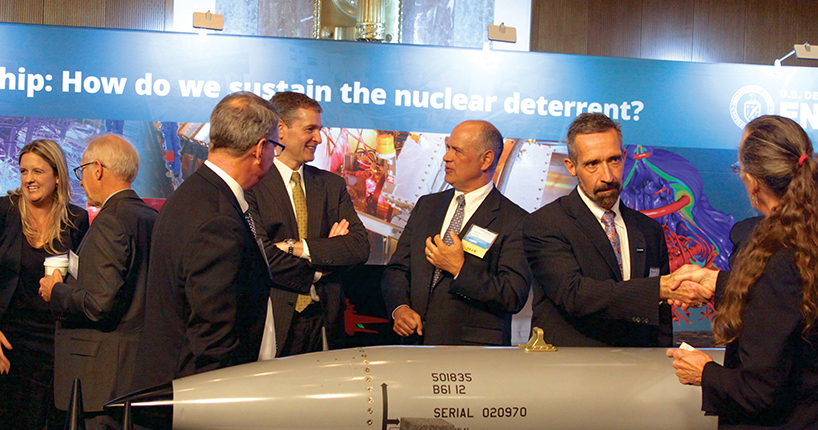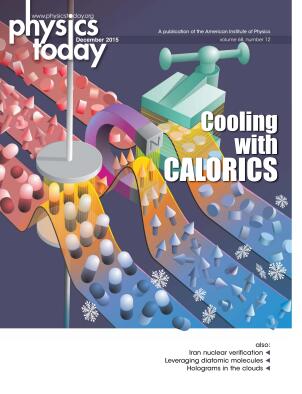Program to characterize US nuclear stockpile declared a success
DOI: 10.1063/PT.3.3016
“Nothing about this program was guaranteed to succeed. There was nothing off the shelf about this,” Secretary of Energy Ernest Moniz declared in kicking off a conference commemorating the 20th anniversary of the Department of Energy’s ambitious plan to keep the US nuclear weapons stockpile reliable and safe without underground testing. Known as the Stockpile Stewardship Program (SSP), the combination of increasingly powerful high-performance computing assets and one-of-a-kind experimental facilities was put in place by President Bill Clinton in 1995, nearly three years into a US moratorium on tests that continues today.

Attendees at a 20th-anniversary celebration of the Stockpile Stewardship Program with a full-scale mockup of the B-61, slated to be the sole bomb in the US arsenal by 2023.
NATIONAL NUCLEAR SECURITY ADMINISTRATION

At the 21 October commemoration and at a Capitol Hill show of technologies developed at DOE’s three nuclear weapons labs, Moniz joined the directors of Los Alamos, Lawrence Livermore, and Sandia National Laboratories and former senior government officials in reminiscing on the origins of the SSP. The original vision was that nuclear testing would be supplanted by more powerful computers and new experimental equipment such as LLNL’s National Ignition Facility, LANL’s Dual-Axis Radiographic Hydrodynamic Test Facility, and Sandia’s Microsystems and Engineering Sciences Applications Complex.
“The concept was elegantly simple; it was only a question of doing it,” Moniz said at the commemoration. The nuclear explosive process was to be broken down into all its major component processes. Each would be experimentally investigated and measured in detail to validate computer simulations. Those models would then be assembled to simulate the entire explosion, and the results would be compared to the vast database of past nuclear tests.
But Moniz, who was undersecretary of energy when the SSP was launched, said problems stood in the way. “None of the experimental tools existed, and the experimental tools that needed to be developed would explore physical parameter spaces, temperatures, and pressures that were unknown in the laboratory.” As for computational capabilities, the 100-teraflops computational capability required for the SSP “was a factor of 10 000 faster than the then-fastest computer, and a factor of 1 million beyond what was typically used by a [weapons] designer in those days,” he said.
A bit wobbly
Moniz acknowledged that the directors of the weapons labs “got a little bit wobbly” for a while about their assurances to Congress that testing could be avoided. Frank Klotz, administrator of DOE’s National Nuclear Security Administration (NNSA) and undersecretary for nuclear security, said some officials doubted whether the nation would provide the necessary resources over the years to carry out the program. Charles Curtis, DOE’s deputy secretary at the time, noted that lawmakers committed a “relatively modest” $4.5 billion a year for 10 years.
The gamble paid off, Klotz said at the commemoration. “Today we can simulate every aspect of a nuclear weapon, from the physics that drives its detonation to the character of its explosive yield and output. In fact, we now have more detailed knowledge about how nuclear weapons work and how nuclear weapons age than it was possible to learn through nuclear explosive testing.” Scientists can look inside weapons with nondestructive testing and make out defects on microscopic scales to uncover aging and design flaws, he added.
To carry out the simulations, the SSP switched from machines that had a handful of processors to massively parallel machines that have thousands of processors. The SSP shortened by 10 years the time it would have taken to accelerate parallel-computing performance by three orders of magnitude, said LANL director Charles McMillan. “But that wasn’t enough, because we also had to really bring the software we developed up to speed on those new platforms,” he recalled. “We had developed a great deal of expertise on Crays when I started. [But] we did not know how to do what we needed to do on the [new] machines. We knew we had to go to 3D, and we had to get all the physics into 3D to do a nuclear calculation.”
The SSP ushered in a new peer-review system of validation in which LANL and LLNL check each other’s work, said LLNL director William Goldstein. “This has been a critical part of success, and it will continue to be part of sustaining confidence.”
Application of the scientific method is key to certifying the performance of the weapons, Goldstein said. That entails “developing hypotheses, theories, models and challenging them with experiments and exercising that loop with the continual application of peer review.”
A leap of faith
The success of the program has eliminated one of the objections that many senators had to ratification of the Comprehensive Nuclear-Test-Ban Treaty (CTBT) in 1999. At the time, the now nearly complete international monitoring system for detecting clandestine underground tests hadn’t been initiated (see the article by Matthias Auer and Mark Prior, Physics Today, September 2014, page 39
Nevertheless, the US remains one of eight nations that still must ratify the CTBT in order for it to take effect. And it’s unlikely that the treaty today would gain the 67 votes required for passage should the Obama administration resubmit it for ratification. Some senators now want to know why the US has ruled out developing new weapons systems when Russia and China are modernizing their forces, noted former National Security Council staffer Franklin Miller. “Why are we imposing restrictions on ourselves that others aren’t?”
As warheads age and their numbers diminish, stewardship challenges remain. “As we reduce the [stockpile] size, it actually means we have to have an even higher confidence in the weapons we retain,” said DOE deputy secretary Elizabeth Sherwood-Randall. A program is under way to modify and extend the life of the kiloton-class B-61 bomb (shown on page 31), the oldest and most plentiful weapon in the arsenal. Once complete, the program will permit the retirement of the last megaton-class weapon in the stockpile, the B-83 bomb. (See Physics Today, December 2013, page 26.) It will also cut the number of nuclear bombs in half, slash by 80% the amount of plutonium and highly enriched uranium in the bomb portion of the stockpile, and lower the bombs’ overall destructive power by a similar factor, she said.
Klotz said the NNSA is preparing for the future of the SSP by rebuilding critical infrastructure, continuing to refine weapons diagnostic capabilities, seeking the exascale level in computing performance by 2023 (see Physics Today, January 2015, page 24
More about the Authors
David Kramer. dkramer@aip.org
